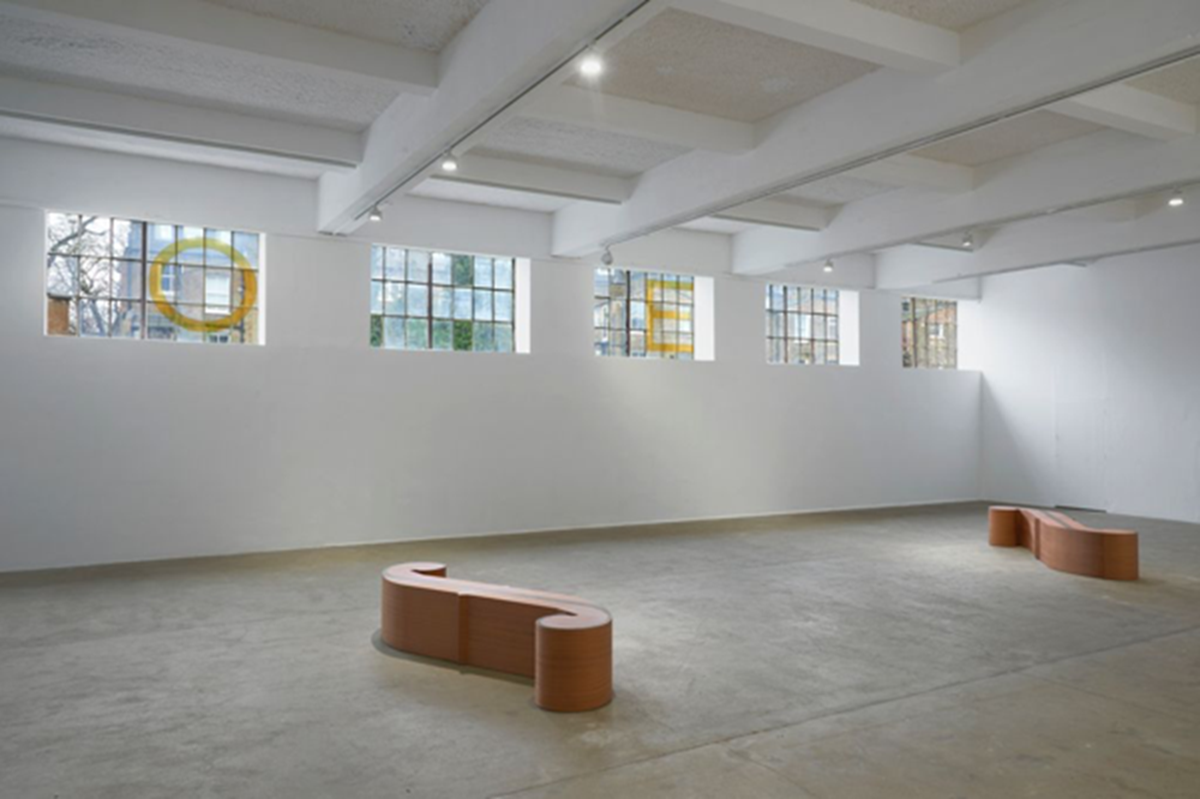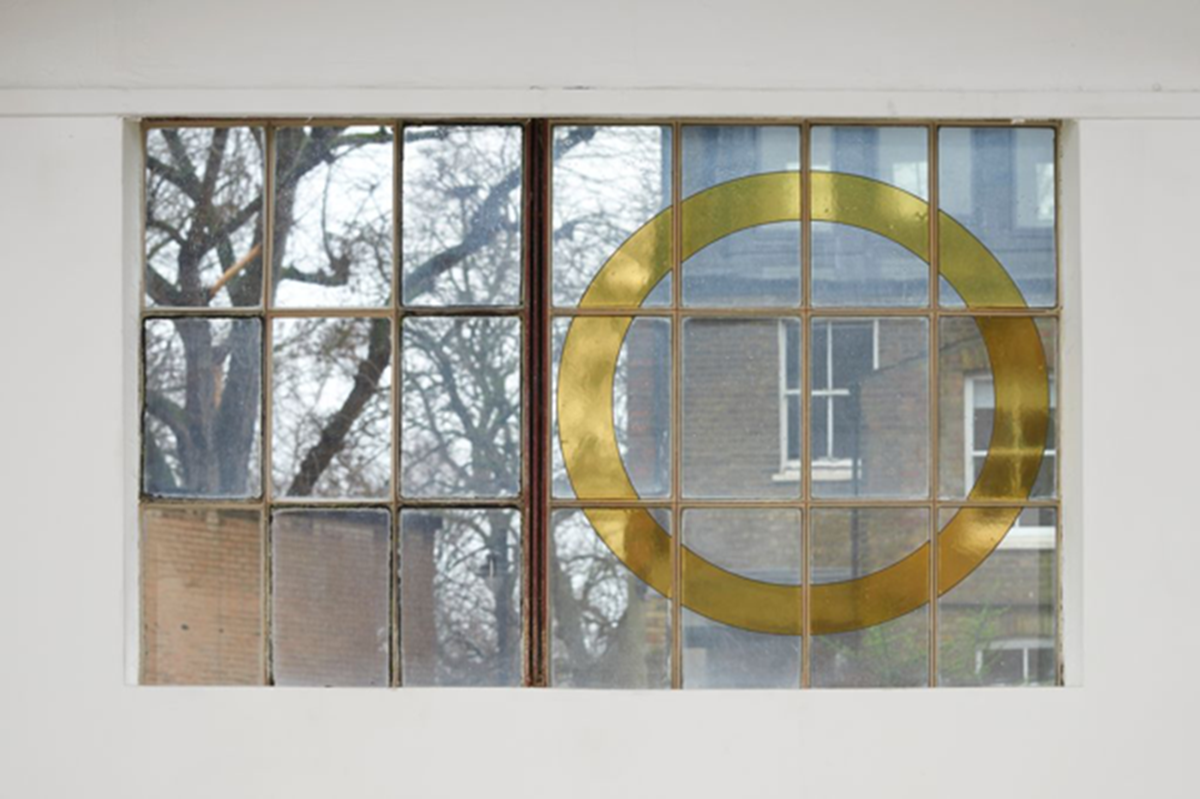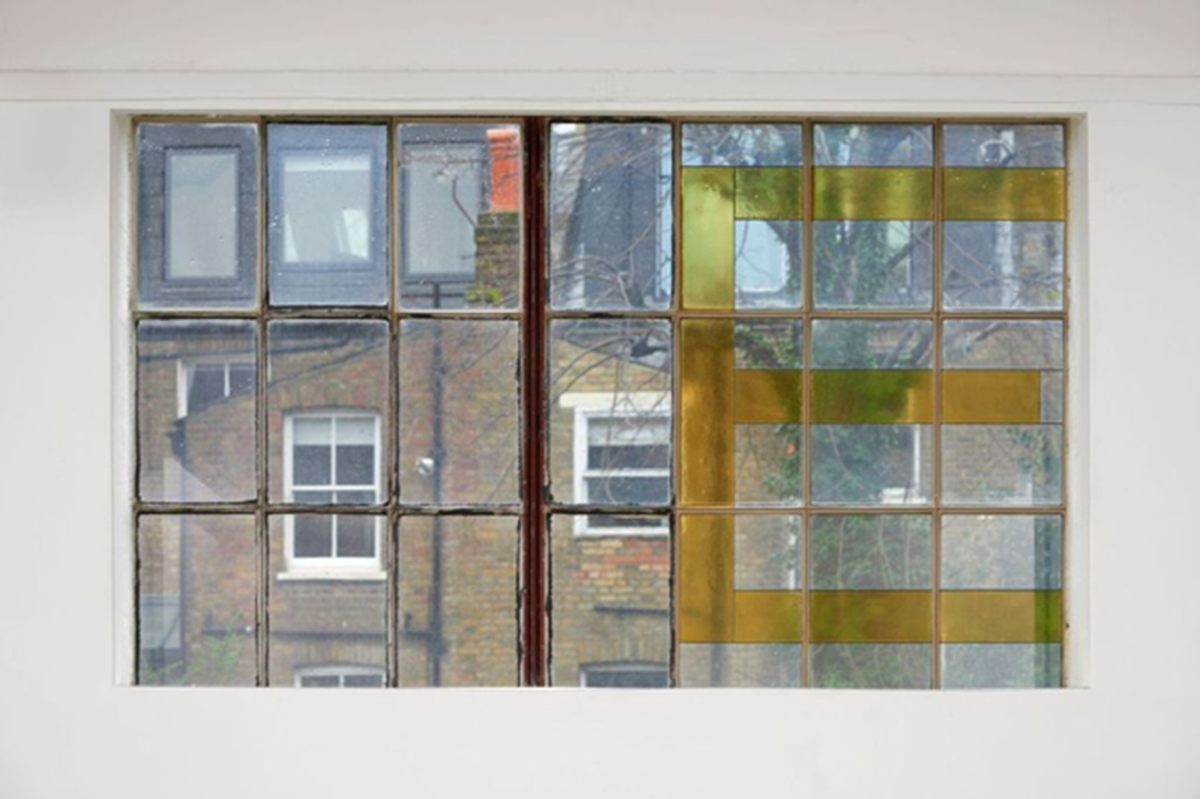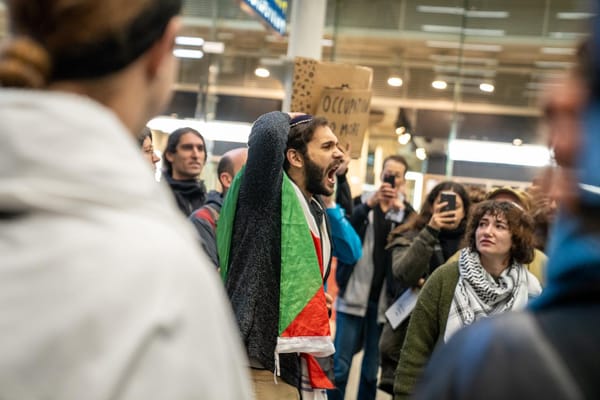The missing O and E
Artist, poet and writer Joshua Leon speaks to Vashti about his first solo exhibition on the construction of British Jewish identity.

The letters C, H, and N are inscribed onto the side of the building that houses the Chisenhale Gallery in London. The letters become visible only when crossing the canal, on which barges once transported the veneers that the building historically manufactured. The missing O and E – which serve as the title for the gallery’s current exhibition – are presented in yellow stained-glass windows, allowing the audience to piece together the last name of the factory owner, Cohen, across multiple planes.
In his latest exhibition, poet, artist, and writer Joshua Leon entangles his own family history with that of the gallery, as he seeks to understand and represent the construction of Jewish identity in Britain. A multidisciplinary and multisensory installation, veneered benches in the shape of a violin’s f-holes invite you to take a seat while the second violin part of Elgar’s Enigma Variations plays, as performed by Leon’s grandfather in the London Philharmonic Orchestra in the 1950s. In the space, the audience is led through material and thematic connections between works to reflect on a web of histories, personal and collective.
Leon spoke to Vashti about the methodologies behind his practice, his approaches to creating knowledge, and the collapsing of the archive.
Diasporic communities and the name
When asked about the setting of Chisenhale as an element of the exhibition, Leon immediately delved into the history of Jewish migration in London’s East End and its relationship with the history of British manufacturing. One example is the veneers mentioned above; another is tailoring. A plaque on the outside of the Chisenhale building states that the veneer once produced there was used to make Spitfires. However, Leon’s research suggests otherwise: veneer was not used to make the Spitfire but the de Havilland Mosquito, a bomber plane that flew significantly higher and faster, and needed to be almost unfathomably light.
On the gallery walls, veneers salvaged from the de Havilland Mosquito days are used to frame a series of London Philharmonic Orchestra concert programmes. Encased in the yellow stained glass of the O and E, the programmes display the ever-changing name of Leon’s grandfather, who was a member of the second violins. In creating material parallels between the gradual changes to Leon’s own grandfather’s name and the transformation of C H N to Cohen, Leon places his grandfather’s assimilation into British identity within a larger history of Jewish migration in the 1900s.

The first act to introduce immigration controls in England was the Aliens Act of 1905, which was ostensibly enforced to regulate the number of Jewish immigrants from Eastern Europe to its shores. It designates migrants as “alien” to the extent of subhumanity. The changing of names, one of the multiple ways in which people signpost a change in their identity, is a form of re-labelling oneself. This is common to this day in many diasporic identities, and Leon’s work situates us in the present as much as it does in the past, given that the Aliens Act continues to other and criminalise immigrants, persuading them to re-identify, to assimilate, to de-alienate themselves. The exhibition focuses on the name as a signifier of identity, the story of which is assembled and reassembled via memory, imagination, and physical forages through the archive. The name of the orchestral piece accompanying the audience through the show, Enigma Variations, thus deserves our full attention. Indeed it is almost synecdoche for the larger proposition of Leon’s work: history is something of an enigma, refusing to be pinned down, made up instead of an infinite number of possible variations.
Pointing out the gaps
Indeed, the artwork is not positioned in a way that attempts to perfect or complete the space and its history. The missing O and E are not placed on the external wall where the faint lines of C H N are visible, but are rather reimagined as stained-glass windows through which light shines into the gallery and onto the salvaged veneer. As Leon reflects,
There’s an element of thinking through repair. I don’t think it’s possible to repair history, that would be ludicrous. It would be like saying, you know, bring back the dead. I just don’t think that’s possible. But you can imagine how that displacement of time has created a kind of condition in which you can think through what repair might look like or feel like or sound like.
In this way, Leon does not attempt to fill in the gaps of history, but rather draws attention to what has been overlooked. With both the stained glass and the second violins, Leon displaces them from their expected context in order that they be noticed. He acknowledges himself as the one pointing out the gaps, the one that has determined the O and the E to be “missing”. His work avoids the proclamation that the O and E ought to be there, but imagines a world in which they were, or are. They are an invitation for the audience to enter into his ruminations.

The second violin part of Enigma Variations plays in isolation, asking us to focus on an instrument so often lost in the immensity of the orchestra. It creates a soundscape that celebrates the pauses, the rhythm, the harmonising notes that are necessary to symphonies, but are normally relegated as secondary. The importance of the pauses is paralleled in the benches shaped like the f-holes of the violin, the empty space of the instrument that diffuses its body’s vibrations to the outside world. Leon thus draws attention to the disregarded, resituating it as essential.
The theory of collapse
The lonely sound of the violin plays into Leon’s larger meditation on how history is fundamentally personal. According to his “ theory of collapse”, his own family history cannot help but be the main subject of the exhibition. He explains,
I use my body, my personhood, my subjectivity, to entangle with history, and to think about history differently. This idea is a theory of collapse. Basically, what I see that as, is that I’m in the archive. So, you could call the missing O and E on the side of the building as a form of inscription that’s in the archive, if you think of the city as a form of archive, or any store of knowledge as a form of archive.
He acknowledges that there is no knowledge void of subjectivity, and thus situates himself, including his imagination, within it. Borrowing the concept of the “tremor” from anthropologist Ann Laura Stoler’s writing about the archive, he explores how digging into an archive causes it to shift, and how any knowledge gained from it will necessarily be stylised through your own subjectivity.
Leon compares the act of learning from the archives to catching an object, suggesting that we always end up finding exactly what we are looking for, whether consciously or not. The entanglement of his family history with that of the gallery embodies this act of catching, and the translation of historical narratives through a lens of one’s own. He says:
I’m looking for the traces in history, and then I’m making my own. I’m sort of in correspondence with history, on some level, history with a very small “h”. ▼
Emma Louise Rixhon is currently doing a PhD exploring how shifting masculine ideals inform and affect male models’ labour practices in London. They are also a photographer and writer.




